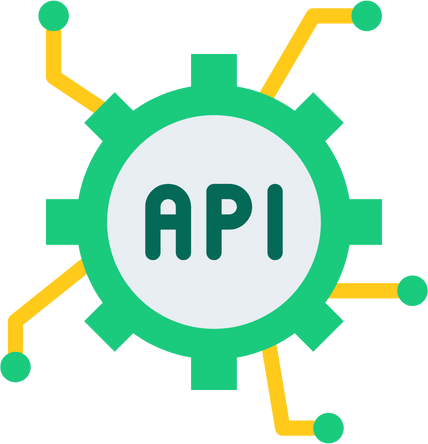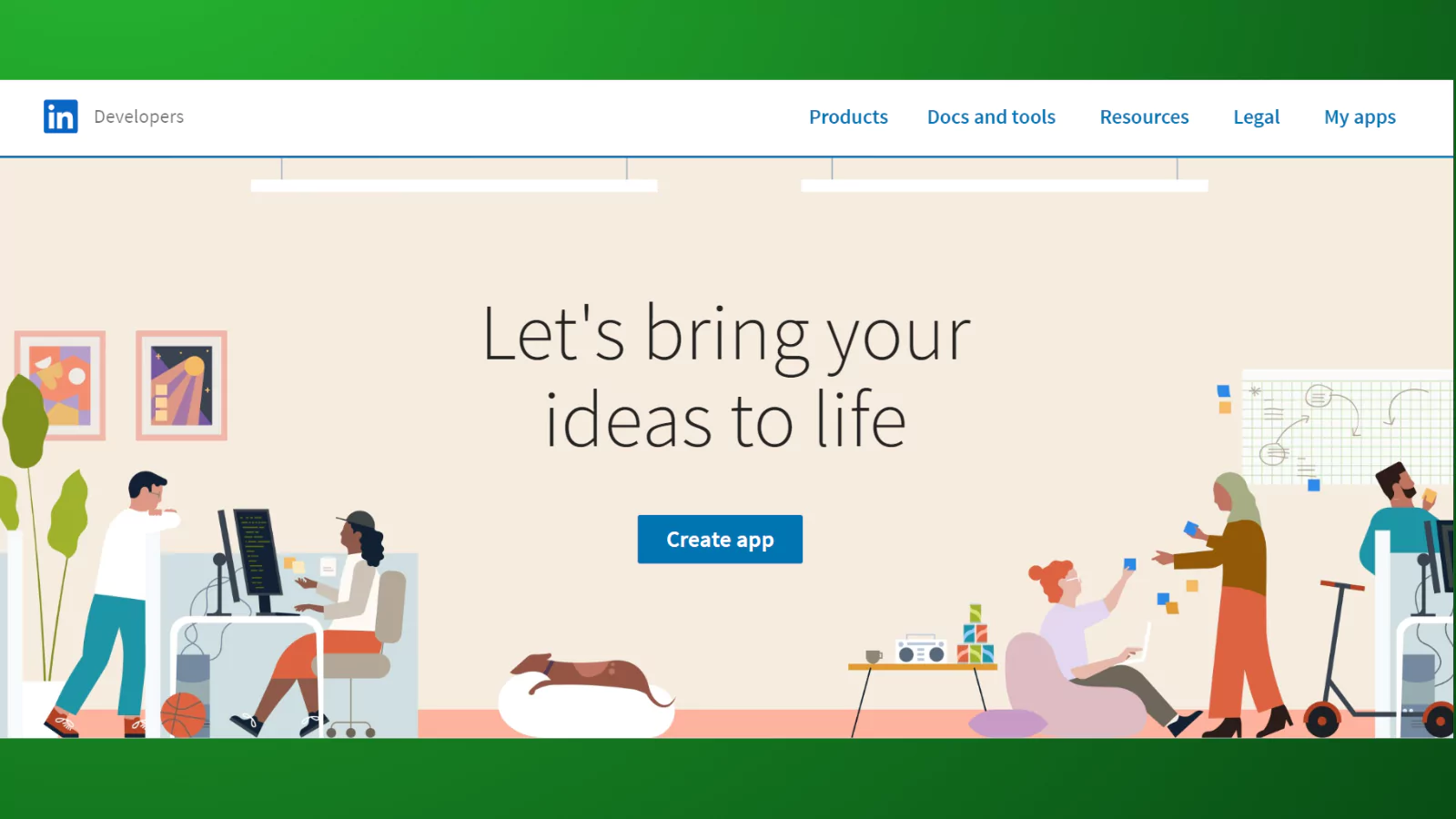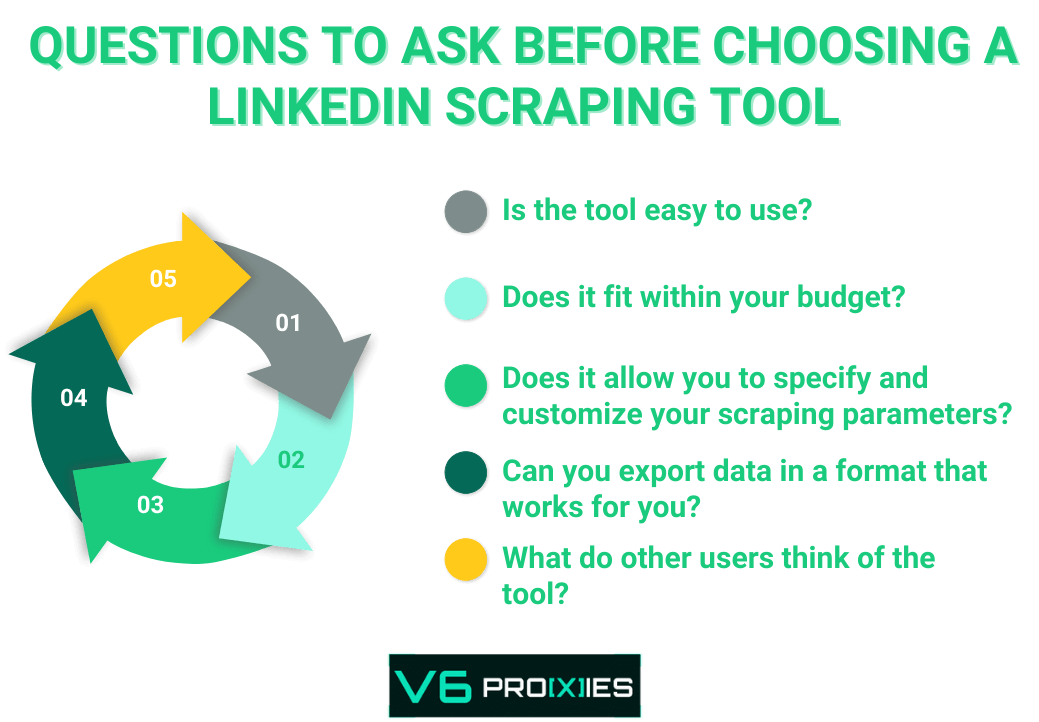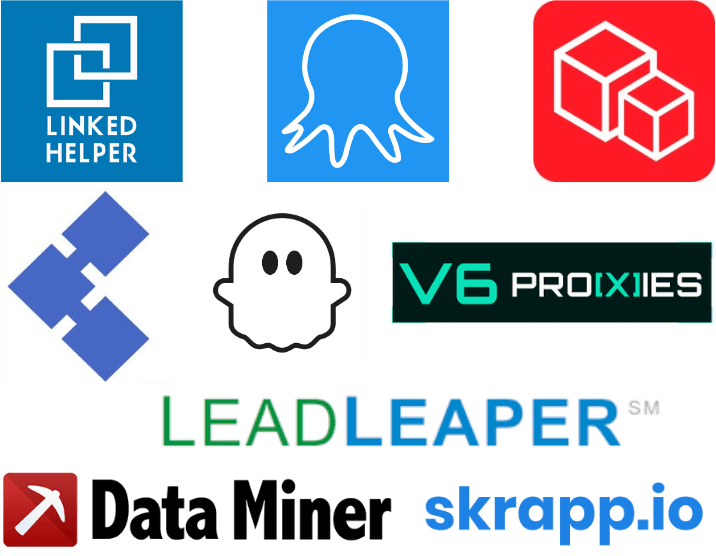The process of LinkedIn scraping refers to the systematic gathering of specific data from LinkedIn. This data can be used for various purposes such as analysis, identifying potential leads, or simply for gaining valuable business insights. In this guide, you will understand the basics of LinkedIn scraping and learn techniques for how to scrape LinkedIn. We will also introduce you to the best LinkedIn scraping tools in 2024’s market.
Table of Contents
- LinkedIn Important Statistics
- What Data Should You Scrape LinkedIn For and Why?
- How To Scrape LinkedIn? (Practical Methods)
- Method 1: Using LinkedIn APIs For Scraping
- Method 2: Using LinkedIn Scraping Tools
- Choosing LinkedIn Scraping Tools: Questions to Ask
- Best 9 LinkedIn Scraping Tools
- What Is The Role Of Proxies In LinkedIn Scraping?
- Main Takeaways
LinkedIn Important Statistics
To let you grasp the huge amounts of data LinkedIn contains, and the potential benefits of scraping it, we gathered these interesting statistics:
- LinkedIn has over 740 million members worldwide.
- LinkedIn is available in more than 200 countries and territories.
- Over 55 million companies have profiles on LinkedIn.
- LinkedIn has an average of 303 million active monthly users.
- LinkedIn has a 57% male and 43% female user base.
- LinkedIn has over 20 million open job listings.
What Data Should You Scrape LinkedIn For and Why?
You might be curious about the types of data you can harvest from LinkedIn and why it’s beneficial. LinkedIn serves as a goldmine of professional details.
This data paves the way for in-depth insights and contributes to the development of many marketing tools and campaigns. The crucial concept here is to understand what is available and scrape what will help you fulfill your specific needs. The data you can scrape from LinkedIn includes:
1. Contact Information
Primarily, many users scrape LinkedIn for contact information. This consists of names, job titles, companies, and importantly, email addresses (when publicly shared). As a business or a marketer, it’s an invaluable resource to create targeted marketing campaigns and sales pitches.
2. Employee Career Data
LinkedIn lets you access extensive employee data. For Human Resources or recruitment agencies, it delivers insights into individuals’ work history, skills, endorsements, and recommendations – essentially a digital resume. Gathering this data is a dream-come-true for recruitment processes and talent mapping strategies.
3. B2B Insights
Looking for detailed organizational data? LinkedIn is a treasure trove that provides nuanced details such as the size of the company, its domain, the sector it operates in, employee statistics, and even geographical information. Insights like these are invaluable when conducting market research or analyzing competition.
4. Job Listing Data
Think of all the insights you could gain if you had access to a quick and organized summary of every job listing on LinkedIn. Well, that’s exactly what scraping LinkedIn job listing data allows you to do. This isn’t just beneficial for job seekers. Enterprises, recruiters, and even academic researchers can leverage this data to understand the market, make informed business decisions, and develop economic insights. The job listing data you can gather includes:
- Job title: Knowing about the most frequently posted job titles can help you gauge the demand for specific roles in the job market.
- Company name: From understanding hiring patterns of specific companies to researching your competitors’ hiring activity, the company name can provide valuable information.
- Location: Do you want to know which cities are emerging as tech hubs or where marketers are in high demand? The location data can give you that information.
- Description: Extracting key words and phrases from job descriptions can give you an understanding about the most sought-after skills in your industry.
- Salary range: While not all listings might have this, when they do, it can provide you insights into the expected salary for various roles.
So, how do you go about collecting data from LinkedIn? Let’s explore that in detail.
How To Scrape LinkedIn? (Practical Methods)
Scraping LinkedIn can be carried out using various methods. The most common ones include using LinkedIn APIs and LinkedIn Scraping Tools. Let’s explore each of these methods in more detail.
Method 1: Using LinkedIn APIs For Scraping
The first and arguably the most straightforward method to extract data from LinkedIn is by using their APIs.
APIs, or Application Programming Interfaces, are sets of rules that allow different software applications to communicate with each other.
In this case, LinkedIn’s API allows you to access certain pieces of data from the platform. To use the LinkedIn’s official API to access data in a structured and authorized manner, follow these steps:
1. Understand LinkedIn’s API
LinkedIn provides various APIs for different purposes. The two main endpoints relevant to data scraping are:
- Search Endpoint: Allows you to search for profiles using specific terms.
- Extract Endpoint: Extracts detailed information from a LinkedIn profile URL.
2. Get API Access
You need authorized access to LinkedIn’s API. This usually requires an application process where you specify your intended use and wait for their response. LinkedIn’s API uses OAuth 2.0 for authentication. Ensure you understand this protocol to proceed.
3. Set Up Your Development Environment
Choose a programming language and set up your development environment. Python is a popular choice due to its simplicity and powerful libraries. Install necessary libraries for HTTP requests (like requests in Python) and OAuth 2.0 authentication.
4. Authenticate with LinkedIn API
Follow the OAuth 2.0 flow to authenticate your application. This typically involves redirecting users to LinkedIn for permission and receiving an access token. Securely store the access token for making authenticated API requests.
5. Make API Requests
- Search Request: Use the search endpoint to find LinkedIn profiles. Construct an HTTP GET request with your search query.
- Extract Data: Once you have profile URLs from the search endpoint, use the extract endpoint to get detailed information. This will also be an HTTP GET request. Handle request limits and paginations as per LinkedIn’s API guidelines.
6. Parse The Response
LinkedIn API responses are typically in JSON format. Use a JSON parser to extract relevant data from the response. Organize the data in a structured format like CSV, JSON, or directly into a database.
7. Handle Errors And Rate Limiting
Implement error handling to manage API request failures or unexpected responses. Respect LinkedIn’s API rate limits to avoid getting your access revoked.
8. Handle Data Storage And Usage
Store the scraped data responsibly, ensuring compliance with data privacy laws and LinkedIn’s policies. LinkedIn wants you to use the data for your specified and authorized purpose only.
9. Maintain and Update Your Code
Regularly update your code to accommodate any changes in the LinkedIn API. Monitor the performance of your scraping tool and make adjustments as needed.
As the API access might be limited and requires an application process. It does not allow for wider possibilities that other Linkedin scrapers provide such as accessing multiple LinkedIn accounts and segmenting data. LinkedIn API is made for developers and advanced users who can write programming scripts.
Method 2: Using LinkedIn Scraping Tools
Scraping LinkedIn is a multi-step process that requires careful planning and incorporation of the right tools. Here’s a simplified step-by-step guide to help you start using LinkedIn scraping tools:
- Select LinkedIn scraping tool: The first step involves identifying and selecting the right LinkedIn scraping tool. Be sure to choose a tool that suits your needs and requirements perfectly. Some of the factors to consider when choosing include user interface, price points, and reviews.
- Specify the details: Once you’ve chosen your tool, the next step involves specifying what data you want to scrape. With most tools, you can define your scraping parameters like searching by company, location, job titles, or skills on LinkedIn. Different scrapers offer different options, so choose carefully to suit your specific needs.
- Run the Tool: After defining your scraping parameters, your next move is to run the tool. Depending on the tool of choice and your specified details, the scraping process may take anywhere from a few minutes to a few hours.
- Analyze and Export Data: Once your tool has completed scraping, it’s now time to analyze your results. Most scraping tools have built-in data analytics to help you understand the collected data. You can then export your data into your desired format such as CSV, Excel, or JSON.
It’s important to note that while scraping data off LinkedIn is generally legal, it’s against LinkedIn’s terms of service. Therefore, it’s crucial to use these tools responsibly, employ proxies to prevent IP blocks, and ensure you’re not invading anyone’s privacy or breaching any confidentiality agreements.
Choosing LinkedIn Scraping Tools: Questions to Ask
Before you commit to a particular LinkedIn scraping tool, there are a few key questions you should ask:
- User-friendliness: Is the tool easy to use?
- Price: Does it fit within your budget?
- Scraping Options: Does it allow you to specify and customize your scraping parameters?
- Data Export Options: Can you export data in a format that works for you?
- Reviews: What do other users think of the tool?
Remember, making an informed decision will ensure that your LinkedIn data scraping experience is smooth and successful.
Best 9 LinkedIn Scraping Tools
When it comes to scraping LinkedIn data, there are hundreds of tools available to make the process more efficient and less time-consuming. These tools often have different features and capabilities, allowing you to choose the one that best fits your specific needs. Let’s explore the top 9 LinkedIn scraping tools on the market today.
1. V6proxies LinkedIn Proxies
For superb LinkedIn data harvesting, consider a LinkedIn proxy like v6proxies. What’s the appeal? These proxies successfully sidestep LinkedIn’s anti-scraping checks, a feature you have to have for scraping success. V6proxies paired with your bots or other scraping tools, allow you to access the diverse data on LinkedIn profiles without getting your IP flagged or blocked.
LinkedIn is compatible with the IPV6 protocol. And this is the main reason we recommend V6proxies. Its IPV6 focus and residential IPs are the best option for accessing LinkedIn with low costs and high impunity against LinkedIn bot detectors.
2. Linked Helper
Moving on to yet another fantastic LinkedIn scraping tool, let’s discuss Linked Helper. This tool has the unique ability to automate many of your LinkedIn tasks. Its platform versatility is impressive, with usability on both LinkedIn and LinkedIn Sales Navigator. Whether you wish to extract emails or automate connection requests, Linked Helper is a formidable ally.
LinkedIn Helper Features Related To LinkedIn Scraping include:
- Profile and Organization Data Extraction: Linked Helper can export people and organization profiles into CSV format. This feature is particularly useful for businesses looking to gather detailed information from LinkedIn profiles for analysis or outreach purposes.
- Messaging History Export: The tool allows users to export their LinkedIn messaging history to CSV. This could be beneficial for analyzing communication patterns or following up on leads.
- Integration with Third-Party Tools: Linked Helper supports sending profile data to third-party applications via webhooks, such as Zapier and Integromat. This integration facilitates the flow of scraped data into CRM systems or other marketing tools, enhancing automation and efficiency.
- Linked Helper CRM: The built-in CRM system in Linked Helper not only manages LinkedIn connections but also scrapes full-profile data. It enriches this data with emails using accounts like Snov.io or Linked Helper’s own Email Finder, providing comprehensive lead information.
- Linked Helper is compatible with all major operating systems, such as Windows, Mac, and Linux, thus ensuring you don’t miss out on this tool’s excellent features due to compatibility issues.
The only problem with this tool is that it is based on cookies rather than proxies, which may limit the accessibility to several LinkedIn accounts and cause speed issues.
With over 300,000 users and seven years of operation, LinkedIn helper has established a significant presence in the market.
3. Octoparse
Octoparse is a powerful, user-friendly scraping tool that doesn’t require any coding skills. It enables you to extract a wide range of data from LinkedIn, including profile details, company information, and job postings. With Octoparse, you can scrape data with a click of a button and export it to your preferred format.
It allows for the scraping of both static and dynamic websites, including those that use AJAX and JavaScript, which can be crucial for sites like LinkedIn.
One of Octoparse’s notable features is its cloud extraction capability, which accelerates data extraction and facilitates access to data from anywhere. This feature is supported by rotating IPs, making it challenging for websites to block or trace your scraping activities.
4. Data Miner
Data Miner is a web scraping extension for Google Chrome and Edge browsers, designed for data extraction and suited for small to medium-scale web scraping projects.
It is user-friendly and versatile, capable of scraping items like product information, contact details, linkedin comments and more. The tool offers over 60,000 pre-set extraction rules and allows custom rule creation.
Data Miner lacks proxy support and API integration though. This limits its use in cases where sites block scraping attempts or for automatic data integration into systems. Though you can use it for scraping linkedin comments, It may not be ideal for complex tasks, such as scraping large LinkedIn profiles data.
The free plan is limited to 500 scrapes per month and if you do exceed the 500 page scrapes in a given month, your account will be locked until you pay for one of their priced plans.
5. Prospeo: LinkedIn Sales Navigator Extractor
Prospeo is a tool for exporting data from LinkedIn Sales Navigator. It allows users to extract up to 45 data points about leads and companies, including verified email addresses.
The tool is designed to find more valid emails compared to competitors and can be used in bulk for extensive lead generation. It integrates seamlessly with LinkedIn Sales Navigator, enabling large-scale data extraction of up to 7,500 leads per day.
Prospeo is available in a free version with 75 credits per month and provides a user-friendly interface for exporting data to Excel.
6. Skrapp
Skrapp.io is an email finder tool designed for B2B sales and email marketing. It integrates with LinkedIn, including Sales Navigator and Recruiter, to help users efficiently scrape Linkedin profile data. Skrapp offers capabilities to find work emails and export LinkedIn search results, catering to various LinkedIn user needs.
It supports both individual and bulk profile scraping and boasts a user-friendly interface. The tool is aimed at enhancing prospecting efforts with verified, targeted emails, and also provides CRM and email service provider sync capabilities. Pricing starts from $49 a month.
7. LeadLeaper
LeadLeaper is a leads discovery and engagement platform that supports LinkedIn scraping. It helps users find and contact leads, adding them to both a leads list and a CRM, with verified business email addresses.
The platform integrates with Google Workspace and Microsoft Office 365 for sending personalized emails, including drip email campaigns. Features include email open and link tracking, meeting scheduling, reminders, call logging, and note recording. LeadLeaper also supports HubSpot’s free CRM with bi-directional lead auto-synchronization. Their free plan is very limited (up to 100 email credits).
8. Helium Scraper
Helium Scraper is a web scraping tool that allows users to extract data from websites using an intuitive point-and-click interface.
It performs fast extraction using multiple off-screen Chromium web browsers and offers a simple workflow with a clean interface. Users can scale extractions as needed and capture complex data, defining their own actions or using custom JavaScript.
Notably, Helium Scraper requires no monthly payments; it’s a one-time purchase with lifetime access. It’s suitable for both home use and on dedicated Windows servers. The tool supports various features like proxy rotation, big data handling, API calling, text manipulation, and scheduling.
9. PhantomBuster
PhantomBuster is a multi-functional scraping tool that includes LinkedIn in its wide range of applications. It’s loved by its users for its automation capabilities and its wide variety of available scraping templates. It is often used for tasks like profile scraping, automated connection requests, and message sending. They offer a free trial for you to see if they suit your needs.
Choosing the right LinkedIn scraping tool ultimately depends on your specific needs and goals. By opting for a tool that aligns with your objectives, you can streamline your data extraction process and gain the insights you need more efficiently.
What Is The Role Of Proxies In LinkedIn Scraping?
Proxies, acting as intermediaries between the user and the internet, mask the user’s IP address, enabling you to scrape data without detection. This is crucial given LinkedIn’s advanced algorithms that can identify and block multiple accounts accessed from the same IP and bot-like behavior. You can read a detailed discussion of Linkedin proxies roles and types here.
Main Takeaways
- LinkedIn contains a wealth of valuable data such as contact information, employee career data, company insights, and job listings that can be scraped for business intelligence and marketing purposes.
- The two main methods for scraping LinkedIn are using the LinkedIn APIs or using third-party scraping tools. The APIs provide authorized access but can be limited, while tools offer more flexibility.
- When choosing a LinkedIn scraping tool, key factors to consider are usability, pricing, scraping options, data export capabilities, and user reviews.
- Top LinkedIn scraping tools include V6Proxies, LinkedHelper, Octoparse, Data Miner, Prospeo, Skrapp, LeadLeaper, Helium Scraper, and PhantomBuster.
- Using proxies is crucial for successful LinkedIn scraping to mask IP addresses and bypass LinkedIn’s anti-scraping mechanisms that block bot-like behavior and multiple accounts accessing from the same IP address.
Related articles
How to Scrape Google Search Results: Tools & Strategies
Facebook Scraping 101 (Everything You Need for Success)
How To Scrape Amazon: A Beginner’s Complete Guide






